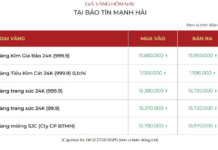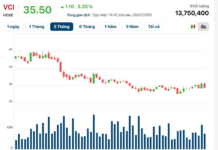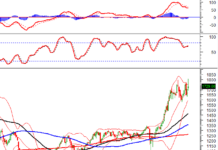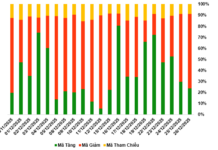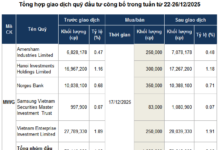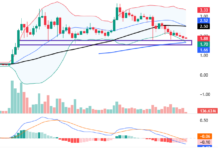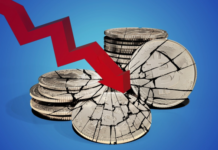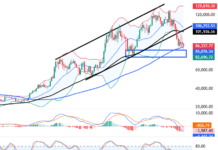
Injecting over 1 quadrillion VND into the economy before the year-end is a challenge. (Int)
According to data from the State Bank of Vietnam (SBV), as of August 16, 2024, credit growth reached 6.25% year-to-date, compared to the end of 2023. Previously, credit growth as of June 30 was recorded at 6.1%. Thus, after a negative growth in July, dropping to 5.66%, credit growth rebounded in the first half of August, increasing by 0.59%.
Earlier this year, at a government press conference, Mr. Dao Minh Tu, SBV’s Deputy Governor, stated that the central bank set a credit growth target of 15% for 2024. Based on outstanding loans of approximately 13.56 quadrillion VND at the end of 2023, this would mean injecting around 2 quadrillion VND into the economy.
To achieve this target, with the outstanding loans as of August 2024, there is a need to inject more than 1 quadrillion VND into the economy in the remaining four and a half months.
Dr. Nguyen Tri Hieu, a finance and banking expert, assessed that after a “accélération” in June, credit growth slowed down in July as the economy needed time to absorb the previous influx. The rebound in the first half of August indicates a recovery in capital demand from various economic sectors.
“Along with a more favorable economic environment, low-interest rates, and the SBV’s loose monetary policy, these factors are expected to influence credit growth for the remainder of the year,” said Dr. Nguyen Tri Hieu.
However, some economists argue that credit growth is uneven, attributing it to the slow absorption of capital by the economy. In particular, the sluggish recovery of the real estate market has significantly impacted credit demand.
Additionally, lending rates have only slightly decreased and remain high compared to the financial health of businesses. At the same time, banks have tightened lending criteria due to concerns over a potential surge in non-performing loans.
Currently, banks are striving to boost credit growth. Vietinbank’s leadership shared that their credit growth reached 7% as of June 22. HDBank reported a credit growth of 13.3% as of June 30, while ACB’s credit growth stood at 12.4% as of the end of June.
Commercial banks are determined to channel capital into the economy, introducing numerous preferential programs and policies to facilitate access to credit for individuals and businesses at reasonable costs.
For instance, Agribank is implementing 14 credit programs and products for new customers, including 9 for individuals and 5 for enterprises. Additionally, Agribank increased the credit limit for the forestry and fisheries sectors from 3,000 billion VND to 8,000 billion VND. Notably, the bank has reduced lending rates four times, with the floor rate decreasing by 0.5-1% per annum. Currently, Agribank’s VND lending rates are among the lowest in the market.
ACB has also deployed comprehensive solutions since the beginning of the year to address bottlenecks and facilitate access to credit. The bank controls input costs to reduce output lending rates while collaborating with enterprises and industry associations, such as construction, textiles, and exports, to boost credit growth.
Some banks are controlling input costs to reduce output lending rates and partnering with enterprises and industry associations in construction, textiles, and exports to stimulate credit growth. Additionally, the growth in the FDI sector, trade, and industrial real estate has contributed to the momentum in credit growth.
Following the Prime Minister’s directive to support economic growth, the banking sector must find solutions to channel capital into production and business activities. Credit institutions that do not fully utilize their credit limits will have their unused portions reallocated to institutions with higher growth potential. This policy serves as an incentive for credit institutions to actively seek ways to boost capital flow and improve access to finance for businesses and individuals.
According to Associate Professor Dr. Nguyen Huu Huan from the University of Economics Ho Chi Minh City, the focus should be on the quality of credit growth rather than the growth rate itself. It is acceptable if credit growth falls short of the 15% target, as long as capital flows strongly into production and business activities. We should not compromise the safety of the system to pursue credit growth targets at all costs, especially when non-performing loans remain a looming concern for the banking sector.
2024: The Year of Economic Recovery
In 2023, our country achieved a GDP growth rate of 5.05%, which, although lower than the target, is relatively high within the region. Economic experts predict that 2024 will be a year of economic recovery and growth.
VPBank strengthens its system in 2023, laying the foundation for sustainable growth
By 2023, VPBank has made significant strides in expanding its customer base and scaling up its operations. The bank has managed to make progress amidst challenging macroeconomic conditions, focusing its resources on strengthening its system and building momentum for sustainable growth in 2024 and beyond.









